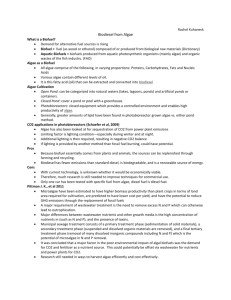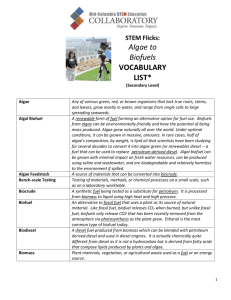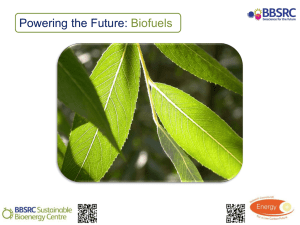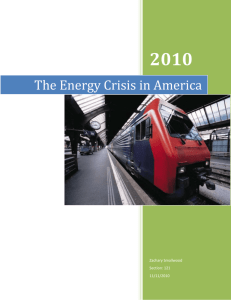JD Okuniewski, Kenny worthington Biodiesel fuel is fuel made from
advertisement
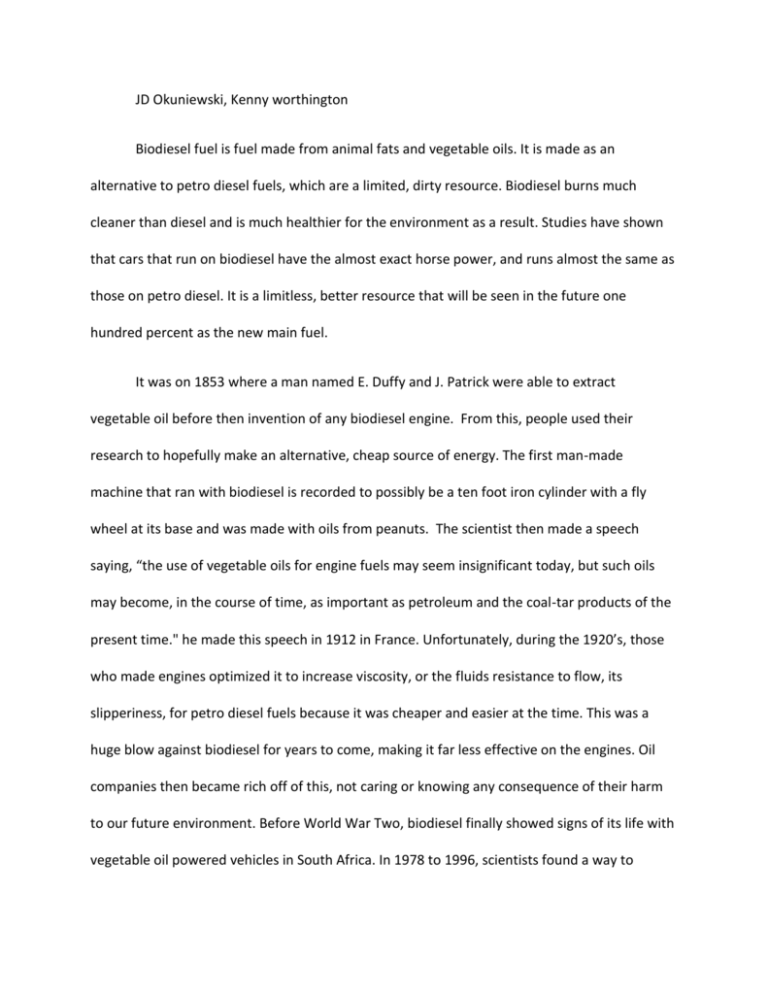
JD Okuniewski, Kenny worthington Biodiesel fuel is fuel made from animal fats and vegetable oils. It is made as an alternative to petro diesel fuels, which are a limited, dirty resource. Biodiesel burns much cleaner than diesel and is much healthier for the environment as a result. Studies have shown that cars that run on biodiesel have the almost exact horse power, and runs almost the same as those on petro diesel. It is a limitless, better resource that will be seen in the future one hundred percent as the new main fuel. It was on 1853 where a man named E. Duffy and J. Patrick were able to extract vegetable oil before then invention of any biodiesel engine. From this, people used their research to hopefully make an alternative, cheap source of energy. The first man-made machine that ran with biodiesel is recorded to possibly be a ten foot iron cylinder with a fly wheel at its base and was made with oils from peanuts. The scientist then made a speech saying, “the use of vegetable oils for engine fuels may seem insignificant today, but such oils may become, in the course of time, as important as petroleum and the coal-tar products of the present time." he made this speech in 1912 in France. Unfortunately, during the 1920’s, those who made engines optimized it to increase viscosity, or the fluids resistance to flow, its slipperiness, for petro diesel fuels because it was cheaper and easier at the time. This was a huge blow against biodiesel for years to come, making it far less effective on the engines. Oil companies then became rich off of this, not caring or knowing any consequence of their harm to our future environment. Before World War Two, biodiesel finally showed signs of its life with vegetable oil powered vehicles in South Africa. In 1978 to 1996, scientists found a way to produce a lot more biodiesel from the contents in algae, in the Aquatic Species Program. Around that time France then released a company that produces biodiesel fuel know as Diester and Germany declared August 10th Biodiesel Day. Although an Oil company bought the company that tried to make biodiesel fuel from algae, it is, again, coming back with a vengeance and will become the leader in biodiesel fuel. Now the new generation will write the next chapter in biodiesel history, and make a newer, cleaner resource to replace oil, which will deplete in about thirty to fifty years. Biodiesel is made by the chemical reaction between the ingredients of oils, fats and alcohol. The oil is not petroleum, a nonrenewable fuel that burns rather filthily; it is instead made purely of vegetable oils or waste oils. The fats are rendered animal fats, which burns well. Biodiesel doesn’t burn more dangerously than petro diesel either. Although some biodiesel products are actually more polluting than crude oil, the source from algae is actually cleaner and an easier way to get a lot from algae than corn or other crops off a standard farm. After much research on this topic, one can conclude that when the actual fuel burns, it should be treated as any other fire. Up close, it’s obvious it can be just as dangerous as oil. It is less polluting in a good amount of sources, so it’s safer for the environment. There are no real dangers that you shouldn’t expect from a fuel that is burning in your car. The research is a bit outdated, but at the look of the costs, biodiesel productions from plants like algae cost a lot more, which makes sense. Petro diesel is a convenient resource. It doesn’t cost much in the way of money to burn. The real cost of it, however, is to our environment. Another cost that can be added is that it’s not permanent, if a country constantly relies on oil, then they will go poor in about 50 years, the estimated time when our nonrenewable resource will run out. One country to look at is Russia, it’s not rich now and economy entirely revolves around oil. It has been estimated that it might take 20 to about 40 years for them to completely deplete in oil, which make them extremely poor. The economic impact would be very powerful and a great investment towards the future. The jobs it will create will increase over time and is estimated to create 500 jobs, 25.4 million dollars in wages, 63.5 million dollars in the San Diego region alone. Imagine putting that into the entire country and being able to create thousands of jobs for Americans. As a matter of fact, we need this boom in jobs right now. Our current economy sucks; let us not even try to hide this fact. Imagine creating a lot more jobs and lowering that unemployed rate so people can support their families. If we switch to this, the frown of the crude oil companies does not outweigh the smiles of the people who can now afford a warm meal. To simply conclude the essay, all one should be able to say is, “Yes”. By looking into what an investment into what is a healthier, limitless, environmentally friendly, and soon more profitable alternative, not much can really go against it. The problem is that not many people see this yet. The light that is shed unto the algae must also be shown to the people around us to show how much better it is than crude oil. Vertical growth of crops or plants, better known as vertigro is when you take a certain crop and instead of spreading the crop out over land, you make it grow vertically in a controlled environment. Vertigro is a relatively new idea. The main crop or plant that is being used with vertigro is algae, which is giving vertigro a bigger name, especially with oil companies. The idea of growing the algae within a vertigro reactor comes from the fact that a person can the algae a create diesel fuel from it. This idea gives oil companies quite the scare. The main task with vertigro is growing algae to create diesel fuel. Vertically growing a crop is much harder of a task then a person would think. First you must create a reactor, and then create all of the right conditions. Especially with the idea of growing algae, the conditions have to be perfect to get the best results. Then to transfer the algae into oil is quite the chemistry project. Through all this though vertigro really helps with pollution. Since algae is a plant it takes in a ton of Co2. So companies are building vertigro greenhouses next to other companies that let off a lot of Co2. The algae takes in the Co2, and gives back out more Oxygen, cleaning the air so to say.Another way vertigro will help us is that hopefully eventually it will replace our need for the use of fossil fuels. The more fossil fuels we use the worse our air is becoming. As stated before the algae takes in Co2 emitted from the burning of fossil fuels. It also could eventually stop the digging for fossil fuels also which ruins our landscape Vertigro could have a huge impact on our economy. This is because it could affect the oil industry. The affect though would 100% be in a good way because the cost to produce algae from vertigro is not outrageous what so ever. This means that when the algae is converted into diesel fuel, when the diesel fuel sells. It is most definitely going to be able to sell at a much lower price than that of regular fuel. Another way that vertigro will be beneficial is because a lot of algae can be produced at one time because it is going upward in a green house. Why did the skyscraper come about, Because there is more room for other building when they are taller rather than wider. The same theory applies here. If a green house is built up higher than the more reactors they can make to grow it. Rather then growing algae in a pond that would be very wide, and would take up a lot of space. The green house is built up, which allows for optimal space allowing more to grow! Intro-ethanol is an alcohol fuel thats distilled from plants some of them are corn and sugar. alcohol fuels have been used for a long time. Has been used for fuel since 1908. Steamed at a high temperature ethene is turned into ethanol. It is a reservable reaction its possible to go back and forth. It is a Biofuel which reduce greenhouse gases. history- It is clear and colorless ethanol is a compound made up of sugars in crops. In the eighteen hundreds ethanol was produced very frequently. But during that time period it was simply used for lamps to run off if it. Ethanol is also a liquor and has been used for moonshine. It was used in 1908 for Fords first car. In place of MTBE ethanol is used for oxygenating fuel, methyl tertiary butyl ether is a fuel additive to oxygenate gas this is done to reduce the production of carbon monoxide while burning fuel. This change is due to the Clean air act. Ethanol is better for the environment, during 1940 ethanol was no sold to american's because of the inexpensive cost of gasoline. In World War One ethanol was used for fuel but also war materials. During 2006 five billion gallons of ethanol was produced. Ethanol is a safer product than gasoline it simply breaks down and causes no harm. A small percent of ethanol is in gasoline this helps the engine run more efficiently. infrastructure- Wet milling and dry milling are the best ways to creat ethanol. Durning dry milling you must use and ethanol producing product like corn or other plant and crush it to produce a flour like substance, many producer call it 'meal' then water is added to it the substance is now called mash. After that enzymes are placed into the mash also ammonia is added to sustain pH. The mash is then cooked at a high temperature then cooled and yeast is added. Then it is fermented for about 45 hours then is is distilled and ethanol is extracted then it is mixed with denaturant and is finished. wet milling the grain is drenched in water and a dilute of sulfurous acid for one to two days the the corn slurry is put through grinders and the corn germ is extracted. the liquor is then evaporated. then the product can either be dried and used as food for live stock or fermented for ethanol. the product is very safe. efficiency- The engine consumption of ethanol is fifty one percent higher than gasoline. Ethanol only engines have more power and also a better fuel economy. To use the full benefits of ethanol the car would need a high compression ratio. High compression engines twenty percent less fuel efficient then gas engines. itcan not be shipped through modern pipelines because of its miscibility. Ethanol would help with thermal efficiency. some blends of ethanol can not handle the cold weather and people would have trouble starting the car. prices would vary by location it would also matter what blend of ethanol is purchased impact- Ethanol would be a benefit because it is renewable. It would also stimulate economic activity creating jobs for many people. manymidwestern states have reaped the benefits of ethanol. many of the midwesternindustry's have expanded and are reaching out. This would help many plant owners because it would help their product sell conclusion- Ethanol can help the country or the whole world it just matters on when the world will start. other resources will run out eventually and then there will be no choice in the matter. It can also help boost the economy which is very necessary right now for this country.



